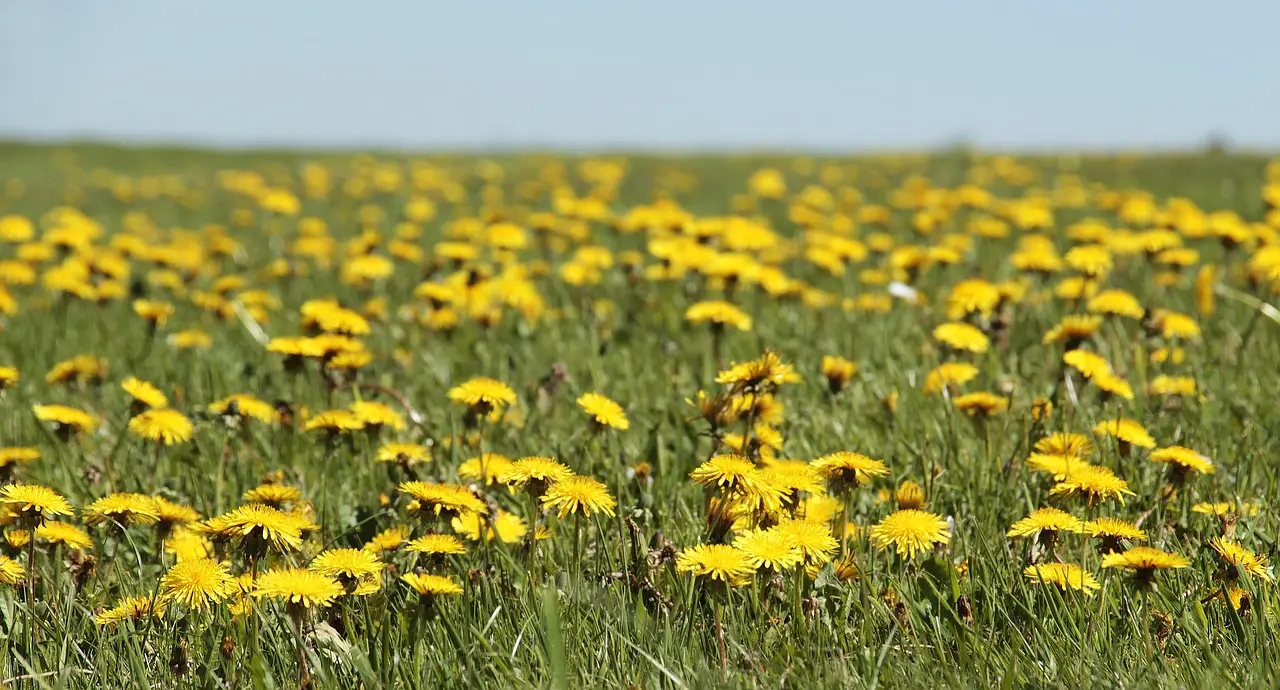Last Updated on November 9, 2021 by Real Men Sow
Perennial weeds appear every year and are difficult to get rid of because most of them have deep taproots. They become the biggest problem when you’re only starting a new vegetable garden on a new plot. However, once you’ve got rid of common weeds, they’ll be less of a problem.
Identify These Common Perennial Weeds
Dandelion
Dandelions are dug out with a trowel. It’s best to remove as much of the parent root so there will be little of them left. It takes 6 – 9 months to get rid of dandelions completely.
 Field Bindweed
Field Bindweed
Bindweed is an invasive climbing shrub that has white or pink trumpet shaped flowers. Field bindweed is not easy to spot, and you’ll have to constantly remove its roots, becoming time-consuming. You can add a thick mulch to suppress it but you’ll still have to check it from time to time.
Creeping Buttercup
The Creeping Buttercup is common to waterlogged ground. The weeds’ tough and shallow roots are the reason why it’s difficult to remove. Mulching is effective when it’s not the growing season, however, if they’re growing vigorously, you’ll have to dig them out. Its roots are shallow and tenacious, so lift them with a good amount of soul and shake the soil off.
 Ground Elder
Ground Elder
Ground Elders’ roots travel horizontally and wind themselves around the roots of other plants. This is why it’s hard to weed them out in busy beds. They also regrow as long as some of their roots are still in the ground. However, it would be too difficult to remove them all. So, keep in check if there are seedlings that emerge, and mulch the surface to exclude light.
Bramble
Brambles look hard to remove due to their tangles of long thorny stems. However, you’ll only need a good pair of gloves that are thorn proof. You’ll have to remove all the stems and remove the roots by forking them out.
Add mulch to the ground after removing them to stop them from growing, however, strong stems may be able to push through it. Dig any new stems after a year or two.
Couch Grass or Scutch Grass
Couch or Scutch Grass is common in most gardens. You’ll only have to remove them by following its roots and gently pulling them out. If you weren’t able to spot any root particles left and weren’t able to remove it, new grass would grow. Mulching the surface of the soil can control them because they prefer growing in more compact and less fertile soil.
Creeping Thistle
Creeping Thistles are removed by pulling them up along with their long tap root. You’ll have to loosen the soil around using a trowel with hands that are gloved.
There’s a chance that you weren’t able to pull all the roots out, so keep in check with any seedlings that may appear on the site you’ve seen them. If you see seedlings, pull them right away to exhaust the parent roots.
Dock Leaves
Dock Leaves can be tricky to remove if they’re around the woody stem of your plants. However, if they’re in an open area, it’s easy to remove them with a sharp spade. You’ll have to lice through the tap root at about 15cm down to remove them as much as possible.
Their matured seed heads produce clusters of brown seeds. These seeds should be burned rather than tossing them in your hot compost pile. However, Dock Leaves without seeds can be composted.
Mare’s Tail
Mare’s Tail is a difficult weed to get rid of because even the smallest fragment of the roots will produce a new plant. It’s best to add heavy mulch around and hoe the area frequently. It’s better to do this because that would starve the roots, however, it would take up to 3 years or more to finish the job.
Plantain Garden Weeds
The Plantain may appear with broader leaves or with narrow leaves. They appear mostly on poorly maintained lawns but also appear in vegetable gardens on paths with compact soil. You’ll have to dig and remove the plants before they have a chance to set their seeds. The plantain has a long taproot, you’ll have to remove its roots as much as you can to stop it from growing again.
Rosebay Willowherb
The Willowherb is an invasive weed, and can be mistaken for lamb’s lettuce. Never let seedlings stay in longer and pull them off before they grow and spread their seeds. The plant grow beautiful pink flowers but if you let them stay, they’ll produce hundred of seeds and would become too hard to handle.
Silverweed
Silverweed is a common type of weed on lawns and paths but can easily invade your vegetable garden. They usually grow in wet compacted soil that has poor drainage. You’ll have to dig them out rather than pulling them out.
Stinging Nettle
Nettles are one of the most difficult perennial weeds to remove by forking them out and its mature plants produce hundreds of seeds that would germinate. However, you can easily hoe them out. Remove the main mass of yellow roots, and the small roots that may have been left will not regrow. You’ll have to wear thick gloves as you handle large plants because the Stinging Nettle can be pretty unpleasant.
How to Get Rid of Perennial Weeds
You can get rid of weeds either by covering, hoeing, mulching, or burning with a gas or kerosene blowtorch. If you prefer natural and easy methods, you can pull annual shallow roots by hand. Household items can be handy, especially vinegar because you can use it to burn the foliage on annual weeds and young seedlings. Weed control fabric is another option to stop weeds rooting down through stone paths.


